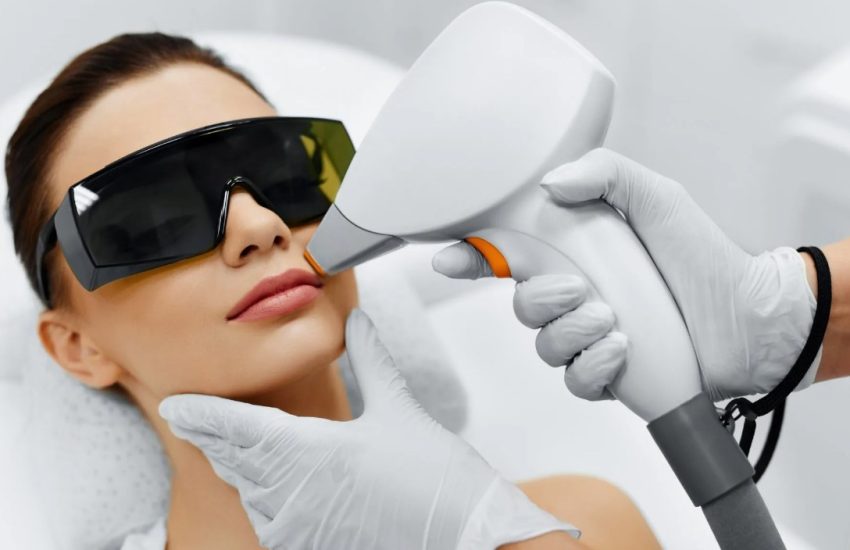Epilation refers to the removal of hair by destroying the hair follicles, preventing regrowth. Unlike depilation, which removes hair at the surface level (such as shaving or using depilatory creams), epilation targets the root of the hair, offering longer-lasting results and, in some cases, permanent hair removal. Depilation is a temporary measure, while epilation provides a more permanent solution. SMART AGE TECH offers advanced epilation equipment and techniques to ensure effective and long-lasting hair removal tailored to individual needs.
Modern Epilation Techniques
1. Electrolysis: This method involves using a needle to apply an electric current to each hair root and follicle, causing them to heat up and be destroyed. Electrolysis can permanently remove hair after a series of treatments. It is suitable for all hair and skin types, making it a versatile option for those seeking permanent hair removal.
2. Photoepilation: This technique utilizes high-pulse light flashes to destroy hair follicles. The light waves target melanin in the hair shaft and follicle, along with the capillaries that nourish them, leading to hair removal. Photoepilation is effective for people with dark hair and light skin, as the contrast allows the light to better target the melanin.
Both methods offer significant advantages, primarily the long-lasting effects. While some treatments can permanently remove visible hair in a single session, others may require a series of procedures for optimal results. The choice between electrolysis and photoepilation depends on individual needs, skin type, and hair color.

Historical Perspectives on Hair Removal
Hair removal is not a modern phenomenon; it has been practiced since ancient times across various cultures. The motivations behind hair removal have evolved, influenced by cultural, social, and aesthetic factors.
Ancient Egypt: Egyptians used silicon and bronze razors, and practiced sugaring, where a sticky mixture of honey and beeswax was applied to the skin, and fabric strips were used to pull off the hair. Women in Egypt removed hair from almost all parts of their bodies, associating hairlessness with beauty and nobility. Body hair was seen as a sign of lower social status. Egyptian queens, such as Cleopatra, were known for their meticulous grooming routines.
Ancient Rome: Similar to the Egyptians, Romans also equated hairlessness with higher social standing. Wealthy women used tweezers, razors, and depilatory creams, and sometimes even pumice stones to scrub off body hair. Roman baths served as social hubs where hair removal was a common practice, highlighting its importance in Roman culture.
Middle Ages: The pursuit of hairlessness continued, with women removing hair from intimate areas and faces, including eyebrows and hairlines, to conform to beauty standards of the time. This era saw the development of more refined tools and techniques for hair removal.
Additional Historical Details
– Mesopotamia: Early depilatory creams made from donkey fat, resin, and plant extracts were used. These creams were heated and applied hot, showcasing the ingenuity of early civilizations in hair removal practices.
– Ancient Greece: Greek women used bronze tweezers and pumice-like materials for hair removal. Hairlessness was considered a sign of youth and beauty, and women of higher social status were more likely to engage in these practices.
– Roman Baths: Romans improved hair removal techniques, utilizing the steam from baths to make hair removal more effective and less painful. The communal nature of Roman baths facilitated the sharing of beauty practices and techniques.
– Ottoman Empire: Turkish baths had designated areas for hair removal, showcasing the importance of this practice. Hair removal was often a social activity, performed in the company of others.
– Elizabethan England: Women plucked forehead hair and used lime to fill the area, followed by hair growth retardants. This practice aimed to create a high forehead, which was a beauty standard of the time.
– 20th Century Innovations: The introduction of safety razors by the Gillette brothers revolutionized personal hair removal, making it easier and safer. The development of electric razors and other devices further simplified hair removal practices.

Modern Hair Removal Techniques
Today, various methods are available for hair removal, each with distinct features, benefits, and drawbacks. The evolution of technology has led to more efficient, less painful, and more permanent solutions.
1. Sugaring: One of the oldest methods, sugaring involves using a paste made from boiled sugar and water. This natural technique is gentle on the skin and effective in removing hair. Sugaring is suitable for those with sensitive skin and is praised for its minimal side effects.
2. Electrolysis: This method remains popular for its ability to permanently destroy hair follicles using electrical current. Electrolysis is precise and effective for small areas, making it ideal for facial hair removal.
3. Laser Hair Removal: Increasingly popular, laser hair removal is considered one of the most modern and effective methods. It uses laser light to target and destroy hair follicles. This method is suitable for large areas of the body and offers long-lasting results after multiple sessions.
4. Photoepilation: Similar to laser hair removal, photoepilation uses flashes of light to destroy hair follicles. This technique is versatile and can be adjusted to suit different skin and hair types.
5. Electro-Optical Synergy (ELOS): A newer technique combining light and high-frequency current for effective hair removal. ELOS is praised for its ability to treat a variety of hair and skin types with minimal discomfort.
Choosing the Right Method
The choice of hair removal method depends on several factors, including skin type, hair color, treatment area, and personal preferences. Consulting with a professional can help determine the most suitable option. For those seeking professional advice and the latest equipment, companies like SMART AGE TECH in Dubai provide cutting-edge solutions in cosmetology.
Conclusion
From ancient practices to modern techniques, hair removal has been an integral part of human grooming rituals. Advances in technology have made hair removal more accessible, efficient, and comfortable. Whether seeking temporary or permanent solutions, the variety of available methods ensures that there is an option for everyone. Understanding the history and evolution of hair removal can help appreciate the sophistication and efficacy of contemporary practices.

I am an award-winning freelance writer specializing in financial topics. With more than a decade of work experience, I have published in the Wall Street Journal, the New York Times and numerous industry journals, including the Harvard Business Review.
